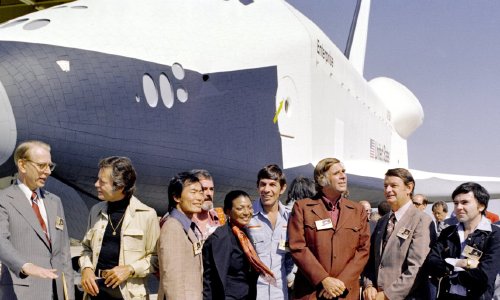Star Trek and reality
Star Trek cast members attend the rollout of the Space Shuttle Enterprise at its Palmdale manufacturing facility on September 17, 1976 (NASA).
I wonder whether the people who put the original Star Trek series together had any inkling that, nearly 43 years after the first episode aired, humanity would have travelled such a great distance in depicting wide-scale human space travel — and such a paltry distance in achieving it.
In that vein, a comparative timeline:
The first episode of Star Trek to be broadcast, “The Man Trap,” aired on September 8, 1966 — four days before Pete Conrad and Dick Gordon flew Gemini 11. Star Trek was deep into third-season dreck before Apollo began flying; the last episode was aired on June 3, 1969 — six weeks before the liftoff of Apollo 11. A total of four Soyuz missions flew during the series’ run. In the context of manned spaceflight in the sixties, Star Trek was very nearly a blip.
Things changed. When Star Trek: The Motion Picture was released, the shuttle was still a year and a half away from its first launch. Americans had not been in space for more than four years. The Soviets, meanwhile, had launched 33 Soyuz missions.
By the time Star Trek II: The Wrath of Khan opened in the theatres, the space shuttle Columbia had flown a grand total of three times. The Soviets, meanwhile, had a crew orbiting in the Salyut 7 space station.
The three Next Generation television series (The Next Generation, Deep Space Nine and Voyager), along with the four movies with the TNG cast, were produced between the Challenger and Columbia accidents. The shuttle didn’t begin flying again until after TNG’s first season.
The first section of the International Space Station was launched a month before the release of the mediocre Star Trek: Insurrection. Deep Space Nine and Voyager were still on the air.
By the time Star Trek: Enterprise began its run, the shuttle had flown 106 times. By the time it was cancelled, NASA was more than two months from resuming flights after the loss of Columbia.
The J. J. Abrams Star Trek is the first movie to be released after the Columbia accident. The shuttle has flown 125 times; the Soyuz program, 101 times.
A lot of Star Trek, a lot of trips to low-earth orbit.
We’re still a decade away from returning to the Moon.
